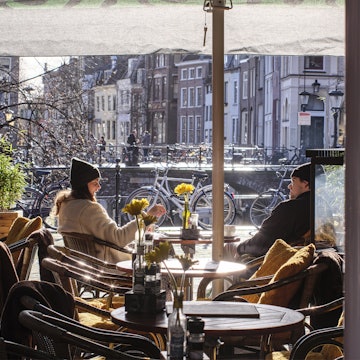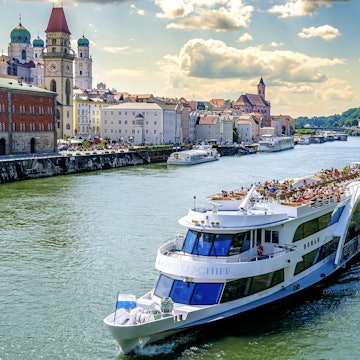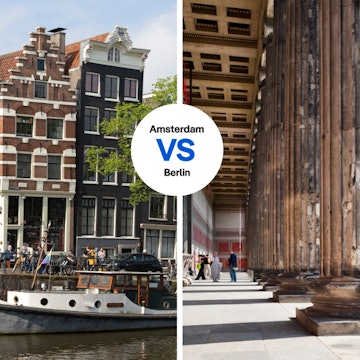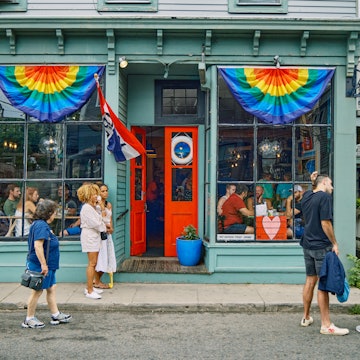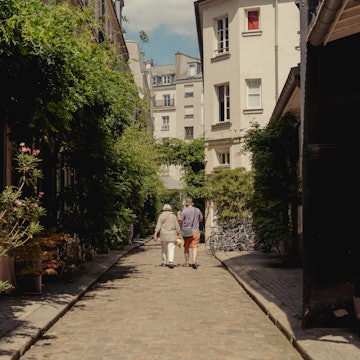
The top things to do in Utrecht, the Netherlands


Dusk along the canals of Utrecht. Sean Pavone/Shutterstock
With historic canals, a lively student vibe and a green periphery dotted with fascinating fortifications, the Netherlands’ second-oldest city is a complete charmer.
Utrecht started life two millennia ago as Trajectum, a castrum (fort) on the Roman Empire’s northern border (or “limes”) guarding the Rhine, which back then still flowed through here. Northumbrian monk-bishop St Willibrord founded a cathedral in the town around 695 CE, and Utrecht subsequently grew into a major spiritual center.
During the Reformation, political-religious turmoil proved especially severe in Utrecht. The bishops lost their secular powers, and 1579’s Union of Utrecht formed the core alliance of the Protestant, anti-Spanish states that would lead eventually to the formation of the modern Netherlands. When the nave of the city’s cathedral blew down in the Great Storm of 1674, Catholics saw it as divine retribution; Protestants, meanwhile, saw the sparing of the tower as a miracle.
Though Amsterdam soon outshone Utrecht economically, Utrecht’s important university (founded in 1636) continued to distinguish the city – and to this day it’s known as the “Cambridge of the Netherlands.”
Indeed, no one will be disappointed by this city’s lively bars, artistic legacy (De Stijl fans know what we mean), numerous nearby castles and all-around winning vibe. Here are some of the very best things to do in Utrecht.

1. Consider Utrecht’s ancient history and medieval churches in the Domplein
The city’s iconic 112m-high belfry tower, Domtoren clocks in as the Netherlands’ tallest – and, after an interminable restoration, is now gloriously free of scaffolding. You can ascend it on an hour-long guided visit stopping at 11m, 25m, 49m and 70m, after which the stairs get a little narrow up to the highest accessible point at 95m.
The gigantic but oddly shaped Domkerk (St Martin's Cathedral) lies across the Domplein. This square is tiled in places with grey octagons: these mark the exact sites of the huge pillars of a nave destroyed by a freak summer hurricane in 1674. (The nave was never rebuilt.) Prebook a DOMunder guided tour to gain access to an underground archaeological site, with artifacts from 2000 years ago resting where they were first dug up.
Another subterranean tour from the same starting point explores the remains of Paleis Lofen, a residence of Holy Roman Emperors that was built around 1020 CE (with floors largely from recycled Roman wall stone). If you want to skip the tour, you can spot a few of its pillars from the rear cellar bar of Walden Bar.
Across the square are tents where archaeologists and restorers often hang out, happy to explain the latest developments about their ongoing research. Behind them, you’ll see a giant rune stone and a gateway carved with St Martin riding a horse. The classic legend is that upon meeting a beggar, the saint removed his red cloak, leaving himself dressed in nothing but his white underwear. The city’s red-and-white colors – down to the blooms in municipal flower boxes – relate to this myth.
Planning tip: To learn more of the stories linked to these central sights, it’s well worth signing up for one of the entertaining, twice-daily “Free” Walking Tours (the guide gets paid based on your tips).

2. See the city glow after sunset
It’s well worth wandering around central Utrecht after dark. Adding to the twinkle of multicolored street illuminations, many shops and restaurants keep their lights on for nighttime window shopping. The over-the-top floral spectacle of Ruby Rose brasserie is particularly memorable.
Utrecht Lumen, a series of light-art installations throughout the center of town, is a visual delight. The easiest to find are the halo above Sint-Willibrod-Kerk (Minrebroederstraat), and especially ’t Tunneltje, whose changing lights subtly color the graffiti in a narrow tunnel passage that descends from Ganzenmarkt to the Oudegracht canal wharf. In midwinter only, the rusty Roman fort-marking strip behind the Domkerk (Achter de Dom) becomes living art, with a curtain of steam onto which lights are projected, creating the impression of a virtual wall.

Meet your new travel partner
Get unlimited data while you travel with Holafly eSIM. Peace of mind and no hidden fees wherever you go. Use code LONELYPLANET for an exclusive discount.
Local tip: Stop in for an after-dark tipple at De Drie Dorstige Herten. Dating back to 1687, this “front room” proeflokaal (tasting house) has nine tap beers, and also serves chasers of local liqueur bitters, Baliekluiver, from an antiquated glass still.

3. Enjoy some of the most charming canals in the Netherlands
The city’s two most charming canals – buzzy Oudegracht and peaceful Nieuwegracht – cut right through the historic quarter; both are unusual for their double-decker towpaths. Long before Amsterdam was of any importance, Utrecht was a major river-trading hub, and merchants offloaded goods into kelders (storerooms) at water level. To transport the goods onward, roadways were built above – hence these canals’ special appearance.
Today, many of the Oudegracht kelders are used as cafés and restaurants, while on Nieuwegracht some kelders are rented out as tourist accommodations (notably through the Court Hotel). To take to the water on Oudegracht or the river-canal that rings the city center, rent 12-seater, electric “party boats” (through Sloepdelen or Utrechtsloep); kayaks and canoes (Kanoverhuur Utrecht); and pedal boats (Stromma). Schuttevaer runs hourly piloted tours in bigger boats.
Local tip: Away from the core canals, on tiny Biltsche Grift, Goesting is a restaurant-café in a former stable where patrons can sip wine or enjoy or more upmarket dinners. Finish things off with a scoop or two of ice cream at Roberto Gelato, in a tiny park nearby.

4. Check out Utrecht’s fabulous independent shops
“Buy Local – Keep Utrecht Weird.” You’ll see this statement on signs in numerous shop windows, underlining Utrecht’s understandable pride in its independent retailers. While you’d need months to get the full scope of Utrecht’s shopping scene, you can get a sense of what’s on offer here with a stroll along touristy Vismarkt and Oudegracht.
Between the many cafés and souvenir shops, Betsies Kookwinkel is a well-stocked kitchenware shop with a satisfyingly traditional flavor, while Rachmaninoff displays furniture and furnishings in an irregular whitewashed canal-side kelder. Further afield, HetFotoAtelier is a treasure trove for photographers, and deliciously niche Passementerie, occupying a house with a notable side turret, specializes in colored threads and ribbons.
One of Utrecht’s many cool vintage clothing stores, Blackfish also has its own label of clothes specially made in India, displayed behind the gloriously preserved shop frontage of a historic pharmacy.
Local tip: The flower market in Amsterdam doesn’t really sell flowers, but in Utrecht, this really is where people stock up on stems and blossoms. Go on Saturdays around 11am, and the church bells will provide a soundtrack.

5. Don’t miss the Rietveld Schröder House
Chances are, if you walked past the residential building at Prins Hendriklaan 50, you wouldn’t look twice. Yet look again, and you’ll soon notice that this 1924 edifice was well ahead of its time: for this is the Rietveld-Schröder House, a high point of the De Stijl movement and a UNESCO World Heritage site.
Entering feels like you’re walking into a 3D Piet Mondrian abstraction. And things get especially interesting when the walls start to move: to make for efficient use of space, celebrated Utrecht designer Gerrit Rietveld created a system that allows the room plan to be substantially adjusted. Guides demonstrate the mechanisms in action.
Planning tip: Prebooking online is essential, as the only way to get inside is via a small group tour. It’s worth arriving at least 20 minutes before your assigned entry time to see a contextualizing video. The location is 2km outside the city’s core; take bus 8 to the Hoogstraat stop.

6. Hop aboard a special train to the Spoorwegmuseum
To make the most of Utrecht’s National Rail Museum (Spoorwegmuseum), count on arriving by the special hourly train from Utrecht Central. You’ll alight at the gloriously restored 1874 station, with its magnificent art-nouveau chandeliers. From there peruse the museum’s countless historic locomotives, a vast collection of model trains, and a range of rides and interactive science experiences for all ages. De Vuurproef is a Harry Potter–meets–Willy Wonka experience that morphs from a history of railways into an award-winning simulator ride. A new exhibit on the future of railways includes Dutch prototypes for hyperloop pods.

7. Pedal your way to Kasteel de Haar
A 45-minute bike ride west of Utrecht, Kasteel de Haar looks like it belongs in a fairy tale from the Middle Ages, from its moat, drawbridge and spiky turrets to the paneled rooms filled with antiques. Yet in truth, the site can hardly be called medieval at all, the 13th-century original having been almost entirely rebuilt by Pierre Cuypers (the architect of Amsterdam’s Rijksmuseum) between 1892 and 1912.
The beautiful French baroque garden near the entrance bears the stamp of Hélene de Rothschild, Cuypers’ wife and heir of the renowned Rothschild banking family (it was her fortune that paid for the 19th-century restoration). A stroll through its plantings with the turrets of the castle looming above is atmospheric indeed.
Planning tip: To round out your cycling day trip, add stops at Slot Zuylen, another fine moated castle; and Castellum Hoge Woerd, whose crown jewel is a 2000-year-old excavated Roman ship.

8. Take a day-trip drive to castles and other historic sites
An interesting day-trip loop heads southeast from Utrecht to lovable Wijk bij Duurstede, which has a compact historical core and a shattered castle that you can admire but not enter. From here, continue east to the sumptuous Kasteel Amerongen, where salon interiors are complemented by a series of projections of 17th-century costumed scenes created by filmmaker Peter Greenaway.
After losing WWI, German Kaiser Wilhelm signed his abdication at Amerongen in 1918. Neutral Netherlands refused to extradite him to be hanged for war crimes – and in 1920 he moved to the slightly less ostentatious Huis Doorn (about 10km to northwest of Amerongen), where he spent his days among the house’s stupendous gardens until his death in 1941.
On the drive back to Utrecht, you’ll pass through the forests of the Utrechtse Heuvelrug National Park; be sure to park beside a tatty little amusement park for the short woodland stroll to “Europe’s biggest pyramid,” the grassy Pyramide van Austerlitz.
Detour: As an alternative, continue on to Amersfoort via the Nationaal Militair Museum, which has an impressive collection of warplanes and military vehicles at a former airbase.
This article was adapted from Lonely Planet’s Netherlands guidebook, published in June 2024.








